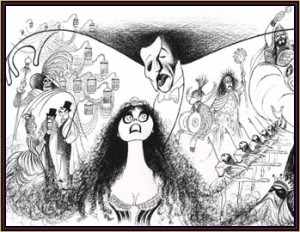 Born to salesman Isaac Hirschfeld and his Russian wife, Rebecca, in St. Louis, just after the turn of the century, the young artist moved with his parents and brothers Milton and Alexander to New York City when he was 12. Hirschfeld studied at the Art Students League but had to drop out of school at age 16 to begin earning a living. He started as an office boy in a movie studio, worked for David O. Selznik as an art director, and wound up for a time in the art department of Warner Bros.
Born to salesman Isaac Hirschfeld and his Russian wife, Rebecca, in St. Louis, just after the turn of the century, the young artist moved with his parents and brothers Milton and Alexander to New York City when he was 12. Hirschfeld studied at the Art Students League but had to drop out of school at age 16 to begin earning a living. He started as an office boy in a movie studio, worked for David O. Selznik as an art director, and wound up for a time in the art department of Warner Bros.
In 1924 the bug that pestered so many young artistic souls of the time bit Hirschfeld and he moved to Europe to make his way working and studying. He focused his attention on a classical training that included drawing, sculpting, and painting and actually intended to make something of himself as a sculptor. But on a return visit to New York, he happened to do a sketch of French actor Sacha Guitry in performance and showed it to a friend, who in turn took it to a contact at the NEW YORK HERALD TRIBUNE. It was published on the theater page and a career was launched.

Hirschfeld's drawing of "The Phantom of the Opera."
Another major trip in the early 1930s, this time to the Far East and most notably to Bali, had a profound and lasting affect on his style. He was intrigued by the expressiveness of simple lines and no color. As he was quoted as saying in PEOPLE, “In Bali the sun bleaches out the color and leaves shadows. You begin to think in lines.” Works from this period were included in his book HARLEM, published in 1941 with text by William Saroyan.
Around this same time, Hirschfeld collaborated with well-known New York writers on books, magazine series, and even a play. He and S. J. Perelman wrote the best-seller WESTWARD HA! OR, AROUND THE WORLD IN EIGHT CLICHES, published in 1948. He illustrated Fred Allen’s TREADMILL TO OBLIVION (1954) and MY YEAR IN THE WHITE HOUSE DOGHOUSE, by Ralph Schoenstein (1969). “Show Business is No Business” was Hirschfeld’s first one-man show, held in 1951. As author and illustrator, he successfully attempted to strip Broadway of its glamour and egotism with text and drawings. HIRSCHFELD FOLIO (1964), THE WORLD OF HIRSCHFELD (1970), and HIRSCHFELD BY HIRSCHFELD (1979) are among the published collections of his works.
In a 1989 NEW YORK TIMES BOOK REVIEW essay on 64 years of illustrating covers for THE NEW YORKER magazine, Hirschfeld wrote: “It is amazing, in flipping through this remarkable collection, to discover how our lives have changed and still remain the same.” The same might be said of the timeless work that has come from Hirschfeld’s hands and mind in eight decades of this century.
Hirschfeld died on January 20, 2003, at his home in Manhattan, New York. He was 99.
Source: Excerpted from NEWSMAKERS 1992, ISSUE CUMULATION, Gale Research, © 1992 Gale Research. Reprinted by permission of The Gale Group.
Photo credits: Photofest, and ©Al Hirschfeld (Art reproduced by special arrangement with Hirschfeld’s exclusive representative, the Margo Feiden Galleries Ltd., New York)

